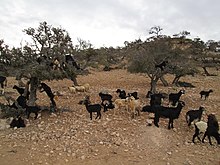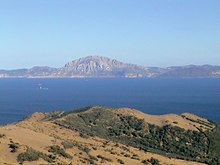Morocco
![]()
The title of this article is ambiguous. For other meanings, see Morocco (disambiguation).
Template:Infobox State/Maintenance/TRANSCRIPTION
Template:Infobox State/Maintenance/NAME-German
Morocco ([maˈrɔko], Arabic المغرب al-Maghrib, DMG al-Maġrib 'the West', Moroccan Tamazight ⵍⵎⴰⵖⵔⵉⴱ Elmaɣrib / ⵎⵓⵕⵕⴰⴽⵓⵛ Muṛṛakuc), officially Kingdom of Morocco (Arabic المملكة المغربية, DMG al-Mamlaka al-Maġribiyya), is a state in northwestern Africa. It is separated from the European continent by the Strait of Gibraltar. The westernmost of the five (with Western Sahara six) Maghreb countries, it borders the Mediterranean Sea to the north, the Atlantic Ocean to the west, and Algeria to the east. Morocco's southern border is internationally disputed due to the Western Sahara conflict until a UN referendum is held on the future affiliation of Western Sahara.
Morocco has been independent again since 1956 and is a constitutional monarchy according to the constitution of 1992. The most important cities in the country are Casablanca, the capital Rabat, Fez, Marrakech, Agadir, Tangier and Meknès. Nine sites are part of the world heritage in Morocco.
Country name
While the country refers to itself in its own official state name al-Mamlaka al-Maghribiyya 'The Western Kingdom' as the "Maghreb Kingdom" (until the 1960s "Sherif Maghreb Kingdom"), internationally the European derivation of the name of the former capital Marrakesh (Moroccan Tamazight ⵎⵕⵕⴰⴽⵛ Mṛṛakc) has become accepted for the entire Kingdom of Morocco.
Geography
In comparison with other African states, Morocco does not have a large national territory, but in its surface form it shows an extremely varied picture. Essentially, the following natural units can be distinguished: the coastal regions in the north and west; the Atlantic region with the Moroccan Meseta; the montane region with the High and Middle Atlas and the Rif Mountains; finally, the transmontane region with the plateaus in the northeastern border region, the Anti-Atlas and the basin landscapes on the edge of the Sahara.
The Mediterranean coast is predominantly steep and rocky and has many capes and bays. Only at the mouth of the Moulouya near the Algerian border does the Mediterranean coastline widen into a basin. In the west, the mountainous coastline runs out into the northwest tip of Africa, which is crescent-shaped and faces Europe.
The Atlantic coast, on the other hand, is a flat, hardly indented equalizing coast with strong sand transport and therefore poorly suited for harbours. Inland, broader coastal plains follow here, such as the lowlands of the Sebou near Kenitra and the extensive coastal meseta of Casablanca. Further inland, the terrain rises to about 450 m above sea level to form the central part of the Moroccan Meseta, a broad tableland landscape also known as the inland meseta or Marrakech plateau. It consists mainly of gently undulating, steppe-like plateaus, with isolated inselbergs rising above.
To the south and east, the Meseta is framed by the striking mountain ranges of the High and Middle Atlas. This huge folded mountain range was uplifted from the sedimentary basin during the Tertiary period when the African and Eurasian plates collided. Earthquakes such as the one in Agadir in 1960 testify to the fact that the mountain-building processes in this area have not subsided to this day. The Atlas Mountains form the morphological backbone of the country and represent both a natural and an economic-cultural barrier. As an important climatic divide, the mountain wall separates Atlantic-Mediterranean Morocco from the Saharan part of the country.
The High Atlas stretches in a slight arc over about 800 km from southwest to northeast. With its rugged, ridged mountain shapes and steep peaks, it has a high mountain character. Here lie the highest elevations of the entire Atlas mountain system and at the same time all of North Africa, including Morocco's highest mountain, the 4167 m high Jabal Toubkal.
To the northeast, the High Atlas continues in the lower Algerian Sahara Atlas; in central Morocco, offset to the north, the Middle Atlas follows for over 300 km. This has in its eastern, steeply to the Moulouya depression sloping chain also over 3000 m high peaks, but otherwise has rather low mountain forms. The northern section of the Moroccan Atlas Mountains is formed by the Rif, a rugged mountain range up to 2456 m high, which stretches from the Strait of Gibraltar parallel to the Mediterranean coast to the estuary of the Moulouya. The longitudinal furrow between the Rif and the Middle Atlas, the "Gate of Taza", is Morocco's main west-east passage valley.
East of the Moulouya valley, which separates the montane from the transmontane region in northern Morocco, the terrain gradually rises to wide, steppe-like plateaus that lead to the highlands of the Schotts in Algeria. The mountain ranges southeast of the main ridge of the Atlas, the Anti-Atlas and its eastern continuation Jabal Sarhro, as well as the parallel Jabal Bani to the south, no longer belong to the Tertiary fold mountains by their structure, but are part of the old African mass. To the south of these are Saharan fringes, including the Tafilalt basin region and the Draa depression.
In the area of the Western Sahara, a wider coastal plain is followed by sandstone plateaus rising to more than 350 m, cut by wadis and covered with dunes, which also belong to the Sahara.
Climate
Morocco's climate shows a transition from the Mediterranean-influenced northwest of the country to the Saharan-continental southeast and south. The High and Middle Atlas, which together form a separate climatic region, form the climatic divide with their main ridge. The northwestern part of the country has hot and dry summers with a mean August temperature of 23 °C and mean temperature maxima between 26 °C (Casablanca) and 29 °C (Tangier). Winters are mild (January mean 12 °C) and rainy, with rainfall decreasing towards the south (Tangier 900 mm, Agadir 200 mm annual rainfall). Inland, the moderating influence of the sea decreases rapidly, so that in the central Meseta and in the Atlas mountains a distinct continental climate prevails: In Marrakech (August average 29 °C) 45 °C can be reached in summer, while in winter the temperatures can be around freezing point; hardly 250 mm of precipitation fall. On the other hand, uphill rains on the western slopes of the mountains sometimes bring more than 1000 mm of precipitation per year, which above 1000 m above sea level usually falls as snow in the winter months. In the Sahara fringes south of the Atlas, an extremely dry and hot desert climate prevails. Rainfall is irregular, rarely reaching 200 mm per year, so that agriculture can only be practiced in oases with irrigation. During the summer months, the scirocco, a hot, dust-laden wind from the Sahara, blows at times.
flora and fauna
The flora is also divided into two parts by the Atlas Mountains: Northwest of the mountains the Mediterranean vegetation predominates, southeast of it the desert steppe. Closed forest stands with holm and cork oaks, thuja, Atlas cedars and Aleppo pines can still be found in the rainy mountain zones and the western plains; they cover only about one tenth of the country's area. Argan trees and jujubes grow in the southern coastal area. In the rest of Morocco, centuries of overexploitation have reduced the Mediterranean vegetation - insofar as it has not given way to cultivated areas - to tree heaths, strawberry trees, pistachios, juniper species and dwarf palms. Above the timberline (at 3100 m) there is a stage of cushion plants. Beyond the Atlas Mountains, dry steppe vegetation with tussock grasses and briars predominates; the hardy half-grass grows in the northeastern high steppe. Date palms are cultivated in the few oases.
Wildlife has retreated into Morocco's sparsely populated areas; some species, such as the leopard and the desert lynx, are threatened with extinction. Other mammals in the country include Barbary macaques (magots), gazelles, hyenas, jackals, and desert foxes (fennecs); reptiles (lizards, chameleons, turtles, snakes) are also abundant. By 2003, 452 different bird species had been recorded in Morocco. 209 species, 49% of the bird species recorded, breed regularly in the country, while 15 species breed only irregularly in the country. Among the bird species recorded are storks, eagles, vultures, buzzards and kites. There are several national parks in Morocco. The area around the Jabal Toubkal in the High Atlas was already declared a national park in 1942. The Ifrane National Park protects extensive cedar forests where Barbary macaques live.

Goats in a field of argan trees
_-_Air_Photo_by_sebaso.jpg)
Morocco Mediterranean coast (west side) - aerial view from Bades over El Jebha to Tétouan with Rif mountains, Tangier-Tétouan region (2014)

View from Spain to Morocco
Questions and Answers
Q: What is the official name of Morocco?
A: The official name of Morocco is the Kingdom of Morocco.
Q: What languages are spoken in Morocco?
A: Arabic, Tamazight, Moroccan dialect (Darija), and French are all spoken in Morocco.
Q: What is the capital city of Morocco?
A: The capital city of Morocco is Rabat.
Q: How large is the population of Morocco?
A: The population of Morocco is over 37 million people.
Q: When did Morocco gain its independence?
A:Morocco regained its independence in 1956.
Q: Who holds executive power in Morrocco?
A: Executive power in Morrocco is exercised by the government.
Q:What religion predominates in Morrocco? A:Islam predominates as a religion in Morrocco.
Search within the encyclopedia